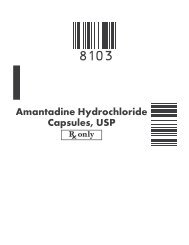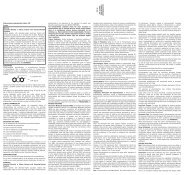Oxandrolone Tablets, USP Rx only - Upsher-Smith
Oxandrolone Tablets, USP Rx only - Upsher-Smith
Oxandrolone Tablets, USP Rx only - Upsher-Smith
You also want an ePaper? Increase the reach of your titles
YUMPU automatically turns print PDFs into web optimized ePapers that Google loves.
29761008<br />
<strong>Oxandrolone</strong> <strong>Tablets</strong>,<br />
<strong>USP</strong> 2.5 mg<br />
<strong>Oxandrolone</strong> <strong>Tablets</strong>,<br />
<strong>USP</strong> 2.5 mg<br />
<strong>Oxandrolone</strong> <strong>Tablets</strong>, <strong>USP</strong><br />
<strong>Rx</strong> <strong>only</strong><br />
BOXED WARNING<br />
PELIOSIS HEPATIS, A CONDITION IN WHICH LIVER AND SOMETIMES SPLENIC TISSUE IS REPLACED WITH BLOOD-FILLED CYSTS,<br />
HAS BEEN REPORTED IN PATIENTS RECEIVING ANDROGENIC ANABOLIC STEROID THERAPY. THESE CYSTS ARE SOMETIMES<br />
PRESENT WITH MINIMAL HEPATIC DYSFUNCTION, BUT AT OTHER TIMES THEY HAVE BEEN ASSOCIATED WITH LIVER FAILURE.<br />
THEY ARE OFTEN NOT RECOGNIZED UNTIL LIFE-THREATENING LIVER FAILURE OR INTRA-ABDOMINAL HEMORRHAGE DEVELOPS.<br />
WITHDRAWAL OF DRUG USUALLY RESULTS IN COMPLETE DISAPPEARANCE OF LESIONS.<br />
LIVER CELL TUMORS ARE ALSO REPORTED. MOST OFTEN THESE TUMORS ARE BENIGN AND ANDROGEN-DEPENDENT, BUT<br />
FATAL MALIGNANT TUMORS HAVE BEEN REPORTED. WITHDRAWAL OF DRUG OFTEN RESULTS IN REGRESSION OR CESSATION<br />
OF PROGRESSION OF THE TUMOR. HOWEVER, HEPATIC TUMORS ASSOCIATED WITH ANDROGENS OR ANABOLIC STEROIDS ARE<br />
MUCH MORE VASCULAR THAN OTHER HEPATIC TUMORS AND MAY BE SILENT UNTIL LIFE-THREATENING INTRA-ABDOMINAL<br />
HEMORRHAGE DEVELOPS. BLOOD LIPID CHANGES THAT ARE KNOWN TO BE ASSOCIATED WITH INCREASED RISK OF<br />
ATHEROSCLEROSIS ARE SEEN IN PATIENTS TREATED WITH ANDROGENS OR ANABOLIC STEROIDS. THESE CHANGES INCLUDE<br />
DECREASED HIGH-DENSITY LIPOPROTEINS AND SOMETIMES INCREASED LOW-DENSITY LIPOPROTEINS. THE CHANGES MAY BE<br />
VERY MARKED AND COULD HAVE A SERIOUS IMPACT ON THE RISK OF ATHEROSCLEROSIS AND CORONARY ARTERY DISEASE.<br />
DESCRIPTION<br />
<strong>Oxandrolone</strong> <strong>Tablets</strong>, <strong>USP</strong>, oral tablets, contain 2.5 mg of the anabolic steroid oxandrolone. <strong>Oxandrolone</strong> is 17β-hydroxy-17α-methyl-2-<br />
oxa-5α-androstan-3-one with the following structural formula:<br />
Molecular Formula: C 19 H 30 O 3 Molecular Weight: 306.44<br />
Inactive ingredients include anhydrous lactose, hypromellose, magnesium stearate, and pregelatinized starch.<br />
Meets <strong>USP</strong> Dissolution Test 3.<br />
CLINICAL PHARMACOLOGY<br />
Anabolic steroids are synthetic derivatives of testosterone. Certain clinical effects and adverse reactions demonstrate the androgenic<br />
properties of this class of drugs. Complete dissociation of anabolic and androgenic effects has not been achieved. The actions of anabolic<br />
steroids are therefore similar to those of male sex hormones with the possibility of causing serious disturbances of growth and sexual<br />
development if given to young children. Anabolic steroids suppress the gonadotropic functions of the pituitary and may exert a direct<br />
effect upon the testes.<br />
During exogenous administration of anabolic androgens, endogenous testosterone release is inhibited through inhibition of pituitary<br />
luteinizing hormone (LH). At large doses, spermatogenesis may be suppressed through feedback inhibition of pituitary follicle-stimulating<br />
hormone (FSH).<br />
Anabolic steroids have been reported to increase low-density lipoproteins and decrease high-density lipoproteins. These levels revert to<br />
normal on discontinuation of treatment.<br />
In a single dose pharmacokinetic study of oxandrolone in elderly subjects, the mean elimination half-life was 13.3 hours. In a previous<br />
single dose pharmacokinetic study in younger volunteers, the mean elimination half-life was 10.4 hours. No significant differences<br />
between younger and elderly volunteers were found for time to peak, peak plasma concentration or AUC after a single dose of<br />
oxandrolone. The correlation between plasma level and therapeutic effect has not been defined.<br />
INDICATIONS AND USAGE<br />
<strong>Oxandrolone</strong> <strong>Tablets</strong>, <strong>USP</strong> are indicated as adjunctive therapy to promote weight gain after weight loss following extensive surgery,<br />
chronic infections, or severe trauma, and in some patients who without definite pathophysiologic reasons fail to gain or to maintain normal<br />
weight, to offset the protein catabolism associated with prolonged administration of corticosteroids, and for the relief of the bone pain<br />
frequently accompanying osteoporosis (see DOSAGE AND ADMINISTRATION).<br />
DRUG ABUSE AND DEPENDENCE<br />
<strong>Oxandrolone</strong> is classified as a controlled substance under the Anabolic Steroids Control Act of 1990 and has been assigned to Schedule III<br />
(non-narcotic).<br />
CONTRAINDICATIONS<br />
1. Known or suspected carcinoma of the prostate or the male breast.<br />
2. Carcinoma of the breast in females with hypercalcemia (androgenic anabolic steroids may stimulate osteolytic bone resorption).<br />
3. Pregnancy, because of possible masculinization of the fetus. <strong>Oxandrolone</strong> has been shown to cause embryotoxicity, fetotoxicity,<br />
infertility, and masculinization of female animal offspring when given in doses 9 times the human dose.<br />
4. Nephrosis, the nephrotic phase of nephritis.<br />
5. Hypercalcemia.<br />
WARNINGS<br />
Cholestatic hepatitis and jaundice may occur with 17-alpha-alkylated androgens at a relatively low dose. If cholestatic hepatitis with<br />
jaundice appears or if liver function tests become abnormal, oxandrolone should be discontinued and the etiology should be determined.<br />
Drug-induced jaundice is reversible when the medication is discontinued.<br />
In patients with breast cancer, anabolic steroid therapy may cause hypercalcemia by stimulating osteolysis. <strong>Oxandrolone</strong> therapy should<br />
be discontinued if hypercalcemia occurs.<br />
Edema with or without congestive heart failure may be a serious complication in patients with pre-existing cardiac, renal, or hepatic<br />
disease. Concomitant administration of adrenal cortical steroid or ACTH may increase the edema.<br />
In children, androgen therapy may accelerate bone maturation without producing compensatory gain in linear growth. This adverse effect<br />
results in compromised adult height. The younger the child, the greater the risk of compromising final mature height. The effect on bone<br />
maturation should be monitored by assessing bone age of the left wrist and hand every 6 months (see PRECAUTIONS, Laboratory Tests).<br />
Geriatric patients treated with androgenic anabolic steroids may be at an increased risk for the development of prostatic hypertrophy and<br />
prostatic carcinoma.<br />
ANABOLIC STEROIDS HAVE NOT BEEN SHOWN TO ENHANCE ATHLETIC ABILITY.<br />
PRECAUTIONS<br />
Concurrent dosing of oxandrolone with warfarin may result in unexpectedly large increases in the International Normalized Ratio<br />
(INR) or prothrombin time (PT). When oxandrolone is prescribed to patients being treated with warfarin, doses of warfarin may need<br />
to be decreased significantly to maintain the desirable INR level and diminish the risk of potentially serious bleeding. (See<br />
PRECAUTIONS, Drug Interactions).<br />
General<br />
Women should be observed for signs of virilization (deepening of the voice, hirsutism, acne, clitoromegaly). Discontinuation of drug<br />
therapy at the time of evidence of mild virilism is necessary to prevent irreversible virilization. Some virilizing changes in women are<br />
irreversible even after prompt discontinuance of therapy and are not prevented by concomitant use of estrogens. Menstrual irregularities<br />
may also occur.<br />
Anabolic steroids may cause suppression of clotting factors II, V, VII, and X, and an increase in prothrombin time.<br />
Information for Patients<br />
The physician should instruct patients to report immediately any use of warfarin and any bleeding.<br />
The physician should instruct patients to report any of the following side effects of androgens:<br />
Males:<br />
Too frequent or persistent erections of the penis, appearance or aggravation of acne.<br />
Females: Hoarseness, acne, changes in menstrual periods, or more facial hair.<br />
All patients: Nausea, vomiting, changes in skin color, or ankle swelling.<br />
Geriatric Use<br />
<strong>Oxandrolone</strong>, at daily doses of 5 mg bid, and 10 mg bid, was evaluated in four clinical trials involving a total of 339 patients with different<br />
underlying medical conditions. The maximum duration of treatment was 4 months with the average duration of treatment from 68.5 days to<br />
94.7 days across the studies. A total of 172 elderly patients ( ≥ 65 years of age) received oxandrolone treatment. Mean weight gain was<br />
similar in those ≥ 65 and those < 65 years of age. No significant differences in efficacy were detected between the 5 mg bid and 10 mg bid<br />
daily doses. The adverse event profiles were similar between the two age groups although the elderly, particularly in women, had a greater<br />
sensitivity to fluid retention and increases in hepatic transaminases. A single dose pharmacokinetic study in elderly volunteers revealed an<br />
increased half-life when compared to younger volunteers (see CLINICAL PHARMACOLOGY). Based on greater sensitivity to drug-induced<br />
fluid retention and transaminase elevations, a lower dose is recommended in the elderly (see DOSAGE AND ADMINISTRATION).<br />
Laboratory Tests<br />
Women with disseminated breast carcinoma should have frequent determination of urine and serum calcium levels during the course of<br />
therapy (see WARNINGS).<br />
Because of the hepatotoxicity associated with the use of 17-alpha-alkylated androgens, liver function tests should be obtained periodically.<br />
Periodic (every 6 months) x-ray examinations of bone age should be made during treatment of children to determine the rate of bone<br />
maturation and the effects of androgen therapy on the epiphyseal centers.<br />
Androgenic anabolic steroids have been reported to increase low-density lipoproteins and decrease high-density lipoproteins. Therefore,<br />
caution is required when administering these agents to patients with a history of cardiovascular disease or who are at risk for<br />
cardiovascular disease. Serum determination of lipid levels should be performed periodically and therapy adjusted accordingly.<br />
Hemoglobin and hematocrit should be checked periodically for polycythemia in patients who are receiving high doses of anabolic steroids.
29761008<br />
<strong>Oxandrolone</strong> <strong>Tablets</strong>,<br />
<strong>USP</strong> 2.5 mg<br />
<strong>Oxandrolone</strong> <strong>Tablets</strong>,<br />
<strong>USP</strong> 2.5 mg<br />
Drug Interactions<br />
Anticoagulants:<br />
Anabolic steroids may increase sensitivity to oral anticoagulants. Dosage of the anticoagulant may have to be decreased in order to<br />
maintain desired prothrombin time. Patients receiving oral anticoagulant therapy require close monitoring, especially when anabolic<br />
steroids are started or stopped.<br />
Warfarin: A multidose study of oxandrolone, given as 5 or 10 mg bid in 15 healthy subjects concurrently treated with warfarin, resulted in<br />
a mean increase in S-warfarin half-life from 26 to 48 hours and AUC from 4.55 to 12.08 ng•hr/mL; similar increases in R-warfarin half-life<br />
and AUC were also detected. Microscopic hematuria (9/15) and gingival bleeding (1/15) were also observed. A 5.5-fold decrease in the<br />
mean warfarin dose from 6.13 mg/day to 1.13 mg/day (approximately 80-85% reduction of warfarin dose), was necessary to maintain a<br />
target INR of 1.5. When oxandrolone therapy is initiated in a patient already receiving treatment with warfarin, the INR or prothrombin time<br />
(PT) should be monitored closely and the dose of warfarin adjusted as necessary until a stable target INR or PT has been achieved.<br />
Furthermore, in patients receiving both drugs, careful monitoring of the INR or PT, and adjustment of the warfarin dosage if indicated are<br />
recommended when the oxandrolone dose is changed or discontinued. Patients should be closely monitored for signs and symptoms of<br />
occult bleeding.<br />
Oral Hypoglycemic Agents:<br />
<strong>Oxandrolone</strong> may inhibit the metabolism of oral hypoglycemic agents.<br />
Adrenal Steroids or ACTH:<br />
In patients with edema, concomitant administration with adrenal cortical steroids or ACTH may increase the edema.<br />
Drug/Laboratory Test Interactions<br />
Anabolic steroids may decrease levels of thyroxine-binding globulin, resulting in decreased total T4 serum levels and increased<br />
resin uptake of T3 and T4. Free thyroid hormone levels remain unchanged. In addition, a decrease in PBI and radioactive iodine<br />
uptake may occur.<br />
Carcinogenesis, Mutagenesis, Impairment of Fertility<br />
Animal Data:<br />
<strong>Oxandrolone</strong> has not been tested in laboratory animals for carcinogenic or mutagenic effects. In 2-year chronic oral rat studies, a doserelated<br />
reduction of spermatogenesis and decreased organ weights (testes, prostate, seminal vesicles, ovaries, uterus, adrenals, and<br />
pituitary) were shown.<br />
Human Data:<br />
Liver cell tumors have been reported in patients receiving long-term therapy with androgenic anabolic steroids in high doses (see<br />
WARNINGS). Withdrawal of the drugs did not lead to regression of the tumors in all cases.<br />
Geriatric patients treated with androgenic anabolic steroids may be at an increased risk for the development of prostatic hypertrophy and<br />
prostatic carcinoma.<br />
Pregnancy<br />
Teratogenic effects – Pregnancy Category X (see CONTRAINDICATIONS).<br />
Nursing Mothers<br />
It is not known whether anabolic steroids are excreted in human milk. Because of the potential of serious adverse reactions in nursing<br />
infants from oxandrolone, a decision should be made whether to discontinue nursing or to discontinue the drug, taking into account the<br />
importance of the drug to the mother.<br />
Pediatric Use<br />
Anabolic agents may accelerate epiphyseal maturation more rapidly than linear growth in children and the effect may continue for 6<br />
months after the drug has been stopped. Therefore, therapy should be monitored by x-ray studies at 6-month intervals in order to avoid<br />
the risk of compromising adult height. Androgenic anabolic steroid therapy should be used very cautiously in children and <strong>only</strong> by<br />
specialists who are aware of the effects on bone maturation (see WARNINGS).<br />
ADVERSE REACTIONS<br />
Patients with moderate to severe COPD or COPD patients who are unresponsive to bronchodilators should be monitored closely for COPD<br />
exacerbation and fluid retention.<br />
The following adverse reactions have been associated with use of anabolic steroids:<br />
Hepatic<br />
Cholestatic jaundice with, rarely, hepatic necrosis and death. Hepatocellular neoplasms and peliosis hepatis with long-term therapy (see<br />
WARNINGS). Reversible changes in liver function tests also occur including increased bromsulfophthalein (BSP) retention, changes in<br />
alkaline phosphatase and increases in serum bilirubin, aspartate aminotransferase (AST, SGOT) and alanine aminotransferase (ALT, SGPT).<br />
In Males<br />
Prepubertal: Phallic enlargement and increased frequency or persistence of erections.<br />
Postpubertal: Inhibition of testicular function, testicular atrophy and oligospermia, impotence, chronic priapism, epididymitis, and bladder<br />
irritability.<br />
In Females<br />
Clitoral enlargement, menstrual irregularities.<br />
CNS: Habituation, excitation, insomnia, depression, and changes in libido.<br />
Hematologic: Bleeding in patients on concomitant oral anticoagulant therapy.<br />
Breast: Gynecomastia.<br />
Larynx: Deepening of the voice in females.<br />
Hair: Hirsutism and male pattern baldness in females.<br />
Skin: Acne (especially in females and prepubertal males).<br />
Skeletal: Premature closure of epiphyses in children (see PRECAUTIONS, Pediatric Use).<br />
Fluid and Electrolytes: Edema, retention of serum electrolytes (sodium chloride, potassium, phosphate, calcium).<br />
Metabolic/Endocrine: Decreased glucose tolerance (see PRECAUTIONS, Laboratory Tests), increased creatinine excretion, increased<br />
serum levels of creatinine phosphokinase (CPK). Masculinization of the fetus. Inhibition of gonadotropin secretion.<br />
OVERDOSAGE<br />
No symptoms or signs associated with overdosage have been reported. It is possible that sodium and water retention may occur.<br />
The oral LD 50 of oxandrolone in mice and dogs is greater than 5,000 mg/kg. No specific antidote is known, but gastric lavage may<br />
be used.<br />
DOSAGE AND ADMINISTRATION<br />
Therapy with anabolic steroids is adjunctive to and not a replacement for conventional therapy. The duration of therapy with <strong>Oxandrolone</strong><br />
<strong>Tablets</strong>, <strong>USP</strong> will depend on the response of the patient and the possible appearance of adverse reactions. Therapy should be intermittent.<br />
Adults<br />
The response of individuals to anabolic steroids varies. The daily adult dosage is 2.5 mg to 20 mg given in 2 to 4 divided doses. The<br />
desired response may be achieved with as little as 2.5 mg or as much as 20 mg daily. A course of therapy of 2 to 4 weeks is usually<br />
adequate. This may be repeated intermittently as indicated.<br />
Children<br />
For children the total daily dosage of <strong>Oxandrolone</strong> <strong>Tablets</strong>, <strong>USP</strong> is ≤0.1 mg per kilogram body weight or ≤0.045 mg per pound of body<br />
weight. This may be repeated intermittently as indicated.<br />
Geriatric Use<br />
Recommended dose for geriatric patients is 5 mg bid.<br />
HOW SUPPLIED<br />
<strong>Oxandrolone</strong> <strong>Tablets</strong>, <strong>USP</strong> 2.5 mg are oval, white, scored, uncoated tablets, debossed with “2.5” on one side and “U” to the left and “S” to<br />
the right of the score on the other side. <strong>Oxandrolone</strong> <strong>Tablets</strong>, <strong>USP</strong> are available in bottles of 100 tablets (NDC 0245-0271-11), bottles of<br />
1000 tablets (NDC 0245-0271-10) and in unit dose cartons of 100 tablets (10 cards containing 10 tablets each) (NDC 0245-0271-01).<br />
Store at 20-25˚C (68-77˚F). Excursions permitted to 15-30˚C (59-86˚F). [See <strong>USP</strong> Controlled Room Temperature.] Dispense in a tight,<br />
light-resistant container with a child-resistant closure as defined in the <strong>USP</strong>.<br />
Keep out of reach of children.<br />
Manufactured for<br />
UPSHER-SMITH LABORATORIES, INC.<br />
Minneapolis, MN 55447<br />
by: Pharmaceutics International, Inc.<br />
Hunt Valley, MD 21031<br />
©2004 <strong>Upsher</strong>-<strong>Smith</strong> Laboratories, Inc.<br />
All Rights Reserved<br />
102976-00 Revised 1008






